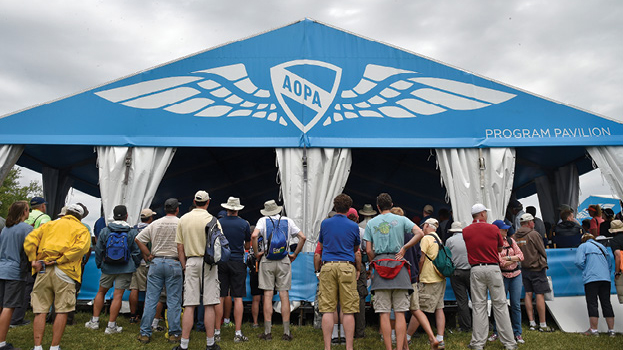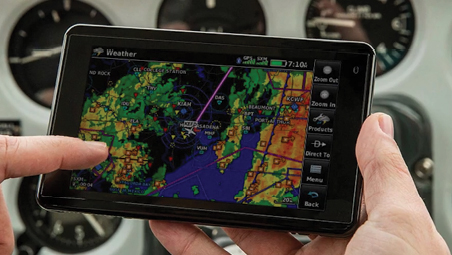
FAA News
Commercial checkrides get less complex
Policy change saves applicants money
Commercial pilot applicants used to have two choices. You could take the practical test in two airplanes, say by doing most of it in a Cessna 172, and performing a “complex demonstration” in a pricier Cessna 172RG. Or you could take the entire ride in the 172RG. The test got even more complicated if you didn’t have easy access to a complex single.
So it was welcome news in April when the FAA announced it had set aside the requirement for commercial pilot or flight instructor applicants with a single-engine airplane rating to provide a complex airplane for the practical test. Complex aircraft—which have retractable landing gear, flaps, and a controllable-pitch propeller—aren’t just often more expensive than their fixed-gear counterparts, they’re becoming more difficult to find on school flight lines. AOPA has long urged the FAA to drop the complex-airplane requirement for the two practical tests.
Training providers had also raised the issue of the scarcity of single-engine complex airplanes, the FAA said in a notice of the policy update, adding that “complex airplanes that are available are older airplanes that are expensive to maintain.”
The policy change comes shortly after an April 4 fatal accident in which a designated pilot examiner and a private pilot who was taking a commercial pilot flight test died after the left wing separated from the 2007 Piper PA-28R-201 they were flying shortly after takeoff from Daytona Beach International Airport in Daytona Beach, Florida.
The policy change does not eliminate the complex airplane training and endorsement requirements of FAR 61.31(e), or existing aeronautical experience requirements (see “It’s Complicated,” right).
The FAA has updated the Commercial Pilot Airman Certification Standards and the Flight Instructor Practical Test Standards to reflect the new policy.
AOPA NEWS
Help wanted
AOPA, JSfirm.com partner for job postings
Job seekers can find the latest career and aviation opportunities directly from AOPA’s website, thanks to a new partnership with the popular aviation-only job website JSfirm.com.
“AOPA is thrilled to be collaborating with JSfirm.com,” said AOPA Senior Vice President of Marketing Jiri Marousek. “Encouraging more people to take advantage of the many opportunities offered in aviation is one of our goals, and providing tools like a job search feature on our website will allow easy access for those looking for careers in the industry.”
Web: http://jobs.aopa.org
Drone discounts
AOPA enhances benefits for drone pilots
Discounts on equipment from Multicopter Warehouse, discounted admission to Commercial UAV Expo in Las Vegas, and an opportunity for free tickets to that show are among the new benefits available to drone pilots who join AOPA as the world’s largest aviation organization steps up its unmanned aircraft offerings.
AOPA launched a drone pilot membership in February 2017. The association already offered drone content and a range of services including educational materials, advocacy, and product discounts to enhance the flying experience of general aviation pilots who fly drones for fun, for profit, or for both.
Web: www.aopa.org/drone
AOPA Membership
Come see us at OSH
The AOPA tent has its welcome mat out
 Do you like backcountry flying—or think you would if you could try it? Then join AOPA at EAA AirVenture 2018 July 23 through 29 for a glimpse of backcountry flying and camping with your aircraft. The AOPA Sweepstakes Piper Super Cub will be on display, as well as AOPA’s You Can Fly Cessna 152 and the California Aeronautical University Cessna 172 in a display honoring the lifestyle of the backcountry. The Sweepstakes Super Cub is a remarkable refurbishment of a 1954 Super Cub by Baker Air Service, the Montana aviation firm owned by Roger and Darin Meggers. The AOPA display will feature a fire ring, camping equipment, and other displays sure to get you excited for a summer of great flying.
Do you like backcountry flying—or think you would if you could try it? Then join AOPA at EAA AirVenture 2018 July 23 through 29 for a glimpse of backcountry flying and camping with your aircraft. The AOPA Sweepstakes Piper Super Cub will be on display, as well as AOPA’s You Can Fly Cessna 152 and the California Aeronautical University Cessna 172 in a display honoring the lifestyle of the backcountry. The Sweepstakes Super Cub is a remarkable refurbishment of a 1954 Super Cub by Baker Air Service, the Montana aviation firm owned by Roger and Darin Meggers. The AOPA display will feature a fire ring, camping equipment, and other displays sure to get you excited for a summer of great flying.
AOPA has partnered with proficiency training company PilotWorkshops and will feature a desktop simulator experience at AirVenture showing how easy it is to stay proficient using inexpensive desktop simulation. In addition, the AOPA Air Safety Institute will offer opportunities to experience its “Safety Challenge” in Redbird TD2 flight simulators.
Visitors can talk with AOPA staff about topics such as insurance and finance, membership, and legal and medical questions, as well as buy AOPA Gear in the AOPA tent. Check it out across from the brown arch on the campus. And each day at the AOPA Program Pavilion, there will be featured speakers and seminars and workshops for all pilots.
NOTICE OF ANNUAL MEETING OF MEMBERS
The annual meeting of the members of the Aircraft Owners and Pilots Association will be held at 9 a.m. on Thursday, September 6, 2018, at the headquarters of AOPA, 411 Aviation Way, Frederick, Maryland, 21701, located on Frederick Municipal Airport (FDK), for the purpose of receiving reports and transacting such other business as may properly come before the meeting, specifically including the election of trustees. If you are not able to attend, but would like to appoint your voting proxy, go online or call 1-800-872-2672. —Kenneth M. Mead, secretary
ASI NEWS
Equipment options
Know your in-flight weather display
By Machteld Smith
 Automatic Dependent Surveillance-Broadcast (ADS-B) Out—which broadcasts GPS position to ground stations and directly to equipped aircraft—will be required after January 1, 2020, in airspace where transponders are mandatory today. Although the directive does not require ADS-B In services, aircraft owners have the option to add features such as in-cockpit traffic and weather.
Automatic Dependent Surveillance-Broadcast (ADS-B) Out—which broadcasts GPS position to ground stations and directly to equipped aircraft—will be required after January 1, 2020, in airspace where transponders are mandatory today. Although the directive does not require ADS-B In services, aircraft owners have the option to add features such as in-cockpit traffic and weather.
As a renter, know what equipment is installed when you book an airplane at your local FBO. You may encounter different cockpit weather system displays and data feeds—some of which rely on satellite and others on ground-based systems. You should understand the subtle differences between these systems, especially if you depend on weather radar during flight in instrument meteorological conditions—these systems are not the same. As an owner, it is equally important to understand the nuances between weather products and their delivery modes before deciding which cockpit weather system best fits your needs.
The AOPA Air Safety Institute Datalink Weather: Choices and Capabilities video reviews the SiriusXM satellite-based system and ADS-B In weather services through the FAA’s Flight Information System-Broadcast (FIS-B) data system. Watch the video to learn how weather delivery modes affect what you see on the screen and how they can help you avoid convective weather in flight.
This video is brought to you by SiriusXM Aviation.
Machteld Smith is an aviation technical writer for the AOPA Air Safety Institute.


